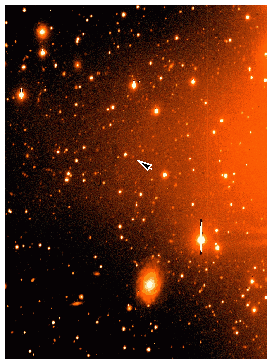 SUMMARY
of the discovery and recent results. (April 30/98)
SUMMARY
of the discovery and recent results. (April 30/98)
Most recent official orbit of BRIGHTER moon.
Telegram 6869 (April 7/98) from the International Astronomical Union
Most recent official orbit of FAINTER moon.
Telegram 6870 (April 7/98) from the International Astronomical Union
Original Announcement telegram (October 1997) from the
International Astronomical Union
May 1/98
Cornell Press release
A colour discovery
image of the faint moon. The glare from Uranus
(placed intentionally off the frame to avoid saturating the
detector) is visible at right. The arrow indicates the faint moon.
DISCOVERY IMAGE of the brighter of the two new moons Observe the motion of the moon (circled) with respect to the background stars. These images were taken roughly one hour apart on Sept. 7, 1997. A faint asteroid in the main belt (not circled) may also be observed and identified by its much faster rate of motion.
A second COLOUR DISCOVERY IMAGE of the faint moon. The glare from Uranus (placed intentionally off the frame to avoid saturating the detector) is visible at right. The moon is circled.
Use your Web Browser's _Back_ button to get back here after you start this MOVIE of the motion of the brighter moon on Sept 6/97. (This takes a little while to load). Note the motion with respect to the background stars. Thanks to J. Moersch, Cornell.
A similar animation of the brighter moon on Oct. 27/97, in the form of a MOVIE is also available (courtesy J.J. Kavelaars, McMaster University). SHOWN AT RIGHT.
Positions of the moons relative to Uranus DURING 1997.
Uranus is shown at the center of the plot (not to scale). The circular orbits of the outermost two previously known moons (Titania and Oberon) surround the planet, and appear as ellipses because the orbits viewed from Earth are somewhat edge on. The four search fields for the discovery observations of Sept. 6 and 7 surround the planet, each box (dashed) showing one field that the digital detector saw during a single exposure. The fainter moon was discovered almost directly east of the planet (note that east is to the left when looking up at the sky while facing south). The brighter moon was west and somewhat north at the time of discovery. The arcs that the satellites followed after discovery are shown, corresponding to the preliminary fits to the orbits of the moons, calculated by Brian Marsden of the Minor Planet Center at Harvard University. The observations from the Palomar 5-meter telescope are shown as large dots. The small squares on Oct. 9 and 18 are two of several observations beginning on the former date by the amateur astronomer Warren Offut. The predicted paths are shown out until December 1, 1997. Observations after that date became difficult due to the fact that the Earth is moving to the opposite side of the Sun than Uranus, and so the planet will become unobservable until the spring of 1998.
An extrapolation into the future of the orbits of the two moons courtesy the Minor Planet Center. The orbit of S/1997 U 2 (the brighter of the two) receeds sufficiently from the planet that apparent position relative to the planet is not uniform due to the Earth's motion.
General solar system background
The JPL Solar System Dynamics Page with tables of satellite data available
OLDER LINKS
Preliminary orbit determination telegram from the International Astronomical Union (Oct 31/97)
Nov 29/97 orbit estimates, as summarized on a telegram from the International Astronomical Union
Original (Oct 1997) University of Toronto New Services Press Release
A somewhat technical summary of the discovery with a list of telephone contacts.
Cornell University Press Release (Oct 1997)
BACK to Brett Gladman's Home page.
![[discs.gif]](http://www.obs-nice.fr/gladman/gladman.ap.jpg)